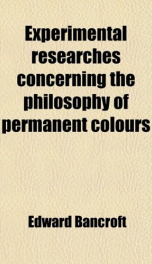experimental researches concerning the philosophy of permanent colours and the

Purchase of this book includes free trial access to www.million-books.com where you can read more than a million books for free. This is an OCR edition with typos. Excerpt from book: EXPERIMENTAL RESEARCHES COHCEBSISG THE PHILOSOPHY PERMANENT COLOURS. PART III. Of Vegetable Adjective Colours. CHAPTER I. Of the Reseda Luteola, Linn., or Weld Plant, and some other Vegetable Yellows. " Lutei video bonorem anliquusimum, in nuptialibus flammeis totum concessum: et fortassia iik.o non numerari inter principales, hoc est, communes maribus ac fa.mini., qaoniim Meieus piucipmtum dcdit." â¬. Plinii secund. Hist. lib. xxi. 8. BY this quotation from Pliny, we learn, that the yellow dye, though highly esteemed from remote antiquity, was exclusively appropriated to the use of women, and that the veil which brides wore on the wedding day, was entirely of that colour. The weld plant seems to have been employed to dye yellow, at least as early as the time when Virgil wrote his Eclogues; for the lutum mentioned in his fourth, (line 44,) was, doubtless, the reseda luteola, which grew wild in Italy, as it does now in various parts of Europe; though the cultivated plant, which is smallest, abounds most in colouring matter. There are some varieties ofthis plant; and of these one was formerly put into my hands, which had been imported from Hamburgh; of which the stalks were not a fourth part so tall, or so large, as those of the plants cultivated in England and France. I did not, however, discover any considerable superiority in the quality of its colouring. matter, though in regard to quantity it yielded more than four times as much as an equal weight either of English or French weld. This smaller variety, according to my information, grows, and is used by the dyers, in several parts of Germany. Weld requires the growth of nearly two summers before it comes to maturity, and the crop is besides liable to fail from so many causes, that it cannot be ...
Info about the book
Author:
Series:
Unknown
ISBN:
0820112844
Rating:
4/5 (1)Your rating:
0/5
Languge:
English
Users who have this book
Users who want this book
What readers are saying
What do you think? Write your own comment on this book!
write a commentif you like experimental researches concerning the philosophy of permanent colours and the try:
Do you want to exchange books? It’s EASY!
Get registered and find other users who want to give their favourite books to good hands!


